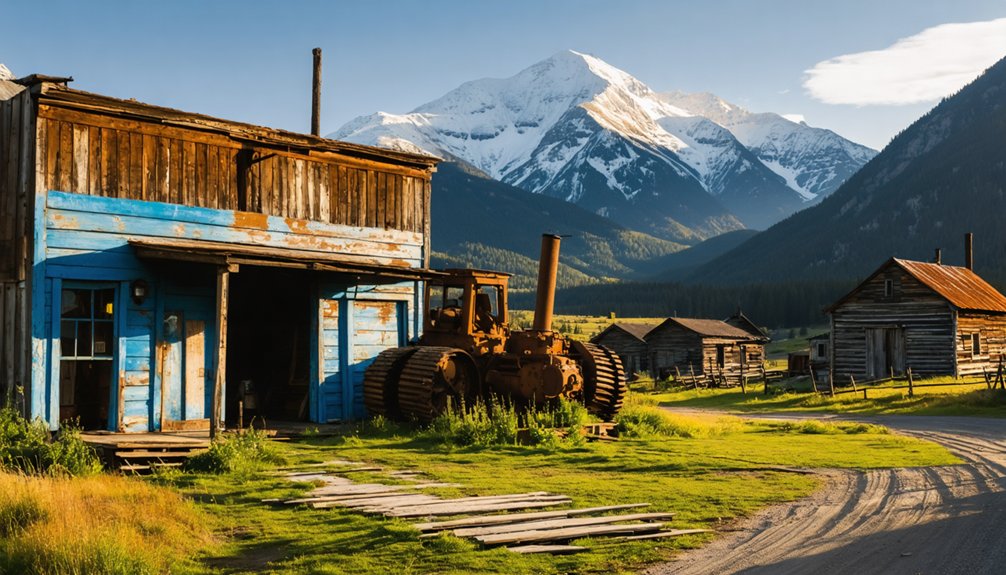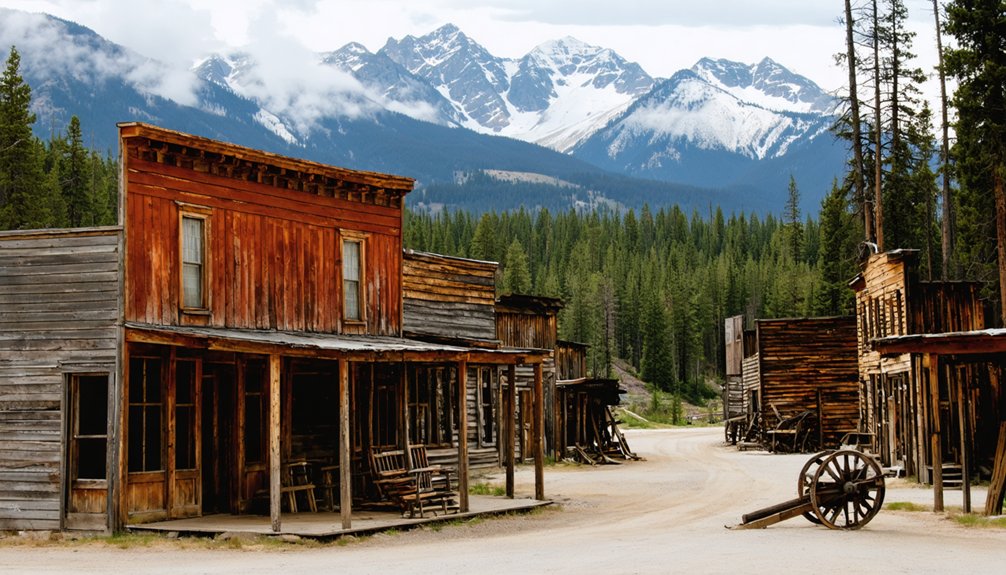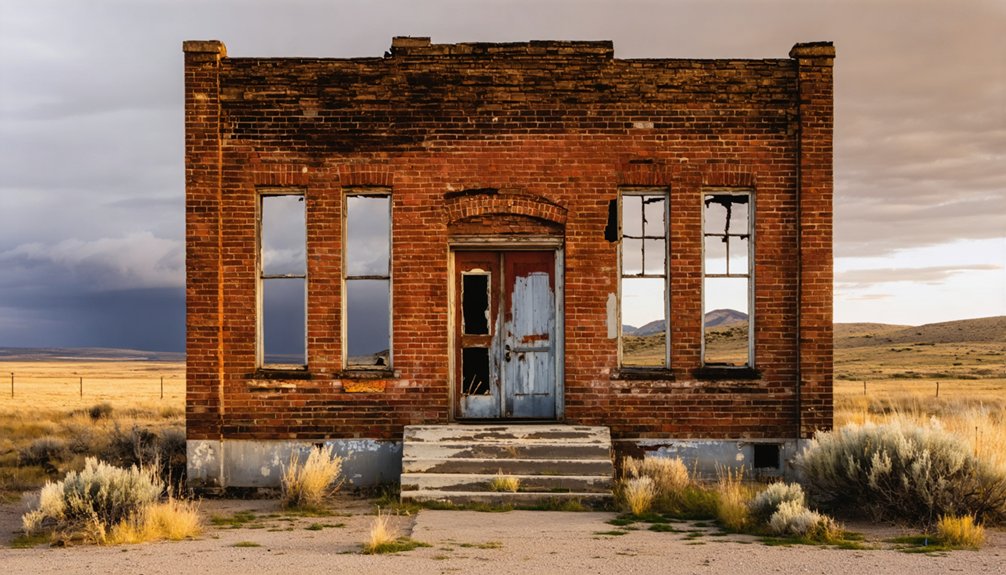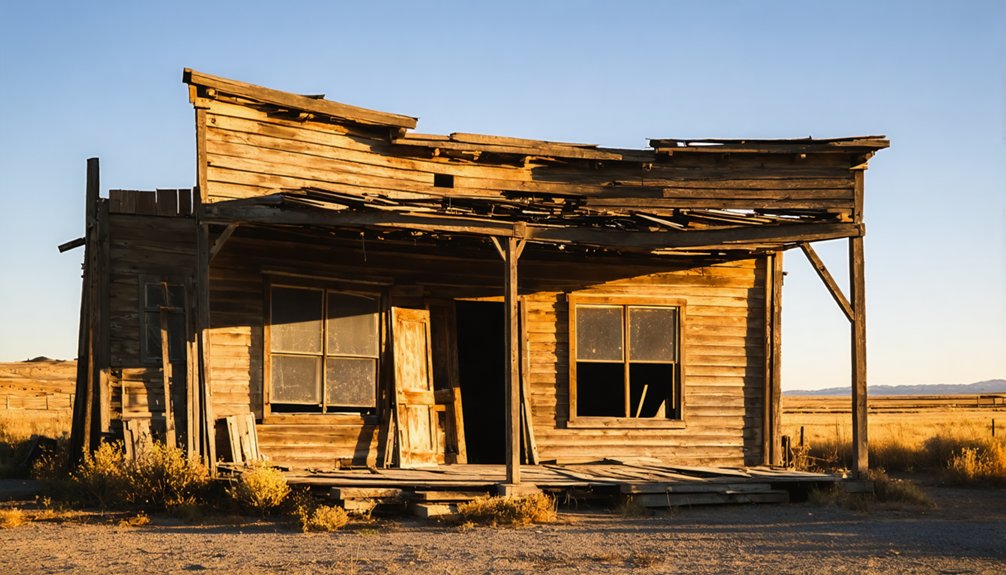You’ll find Warren, a historic mining town established in 1862, tucked away in Idaho’s Payette National Forest. After James Warren’s gold discovery, the settlement quickly grew to 1,500 residents and produced $15 million in gold. The town later flourished with a significant Chinese population, innovative agriculture, and colorful characters like Polly Bemis. Today, this remote ghost town preserves its mining structures and cultural heritage, offering a window into Idaho’s golden past.
Key Takeaways
- Warren is a former gold mining town established in 1862 that produced approximately $15 million in gold during its active years.
- The town reached a peak population of 1,500 within three years of its founding but experienced significant decline as mining operations diminished.
- Chinese immigrants became the majority population by 1880, contributing to the town’s development through agriculture and commercial enterprises.
- The historic Warren Wagon Road still connects the ghost town to McCall via Highway 55, making it accessible to modern visitors.
- Warren is now recognized as a National Register site, preserving its mining heritage while facing ongoing preservation challenges.
The Discovery That Started It All
When James Warren led a party of prospectors from Florence camp to Warren Creek in 1862, he couldn’t have known his discovery would establish one of Idaho’s most enduring mining settlements.
The initial gold prospecting techniques revealed promising deposits, leading 18 determined men to officially organize a mining district by July 22. You’ll appreciate the mining camp hardships these pioneers faced – they’d to traverse a treacherous mile-deep canyon along the Salmon River just to reach the site.
Despite the challenges, word spread quickly. By September, merchants had established a log cabin store to supply the growing camp. Today, this historical area is easily reached via the Warren Wagon Road that connects to Highway 55 in McCall.
Growth was inevitable – even with the harsh conditions, enterprising merchants soon arrived to serve the bustling mining settlement.
The settlement’s rapid expansion was remarkable – by winter, 375 men were working the placers, making Warren second only to Florence in size among the region’s mining communities. The town faced ongoing challenges from harsh weather and flooding, but the miners’ determination kept operations going.
Life During the Gold Rush Years
As Warren’s mining district took shape in mid-1862, the settlement quickly transformed from a primitive camp into a bustling hub of activity.
You’d find miners working the creeks with rocker boxes, pulling up to 75 ounces daily. The social dynamics were unique, as Warren’s founders aimed to create a peaceful, orderly community – quite different from the rougher atmosphere in nearby Florence. A sizable Chinese population moved into Warren during the 1870s and found acceptance working abandoned claims. Heavy snowfall meant winter supplies had to be stockpiled months in advance.
- You could earn $15-$20 daily working the placer deposits
- Your mining techniques would evolve from simple panning to hydraulic methods
- You’d join a population that swelled to 1,500 within three years
- Your gold finds would contribute to the district’s $2 million first-year yield
- You’d witness the shift from placer to lode mining as stamp mills arrived
Rise and Fall of a Mining Empire
You’ll find Warren’s remarkable story began in the summer of 1862, when James Warren’s prospecting party discovered rich gold deposits yielding up to $17 per ounce in the Warren Basin.
The mining camp’s population exploded to 1,500 within three years, producing an estimated $2 million in gold during its first year alone.
While the initial placer mining boom faded as surface gold diminished, Warren’s shift to hard rock and hydraulic mining helped sustain operations well into the 20th century, though never again matching the productivity of its early years. Like many western mining operations, Warren faced significant challenges when national regulations shutdown mining activities from 1935 to 1942.
Gold Rush Beginnings
During the summer of 1862, prospector James Warren and his party struck gold in central Idaho’s remote Salmon River wilderness, launching what would become one of the territory’s most enduring mining settlements.
Within months, you’d find 375 hardy souls working the rich placer deposits of Warren’s Diggings, named after its discoverer. The district’s gold-bearing gravels proved exceptionally deep and extensive, yielding up to 75 ounces daily through simple rocker boxes. The area has remained an active gold mining site since its discovery in the 1860s. The mining operations ultimately yielded over $4 million in gold through dredging when gold was priced at $35 per ounce.
- Miners extracted an impressive $2 million in gold during the first year alone
- A makeshift store and log cabins quickly emerged to support the growing community
- Prospectors spread across multiple gold-rich creeks in the district
- Mining techniques focused on working the rich river gravel beds
- Despite the region’s isolation, supply chains developed to sustain year-round operations
From Boom To Bust
While Warren’s initial gold rush sparked tremendous excitement, the mining district’s evolution followed a more complex trajectory than the typical boom-and-bust cycle.
You’d have seen the population surge to 1,500 miners within three years of the 1862 discovery, then settle to around 500 as surface gold became scarce.
Unlike many mining camps that simply died out, Warren adapted through evolving mining techniques. When placer deposits dwindled, the district shifted to lode mining in the late 1860s, with stamp mills processing ore on-site.
The town’s orderly nature and established infrastructure helped sustain a long-term mining community rather than brief bursts of activity. Even as the original boom faded, technological advances like hydraulic mining and dredging kept operations going well into the 20th century.
Chinese Heritage and Cultural Impact
The discovery of gold in Warren Creek in 1862 set the stage for a remarkable chapter in Idaho’s cultural history, as Chinese immigrants transformed this remote mining town into a uniquely diverse community. Mutual respect and need formed strong bonds between Chinese and white residents as they worked together for shared prosperity.
By 1880, you’d have found a thriving cultural legacy where Chinese residents outnumbered whites three to one, creating a rare example of peaceful coexistence in the American West. The community’s agricultural success was evident in their production of vegetables and fruits that supported both local needs and commercial trade.
- The famous Ah Toy Garden on China Mountain showcased innovative terraced farming techniques
- Chinese miners received equal rights to buy and work mining claims, unlike in other Western towns
- Local Chinese residents established extensive support networks and commercial enterprises
- The community maintained advanced irrigation systems for agriculture and mining
- Archaeological evidence, including metal tools and artifacts, reveals the rich cultural dynamics
Notable Characters and Local Legends

You’ll find few stories more engaging from Warren’s history than that of Polly Bemis, a Chinese woman who arrived as a slave but rose to become one of the town’s most beloved figures through her marriage to Charlie Bemis and her remarkable resilience.
The town’s landscape was further colored by distinctive characters like Three-Fingered Jack, Judge Poe, and the wilderness-savvy Cougar Dave, each contributing their own chapter to Warren’s rich tapestry of mining-era tales. By 1884, the town had produced an impressive wealth exceeding $14 million through its successful gold mining operations.
These individuals shared the stage with James Warren himself, the town’s namesake who discovered gold in 1862 and helped establish Warren’s reputation as an unusually orderly mining camp.
Polly Bemis’ Remarkable Story
Among Warren’s most celebrated historical figures, Polly Bemis stands out as a remarkable pioneer whose journey from indentured servitude to respected community member exemplifies the complex narrative of Chinese immigrants in the American West.
Polly’s resilience shines through her transformation from a young woman sold into slavery to becoming a beloved member of the Warren community. Today, her legacy lives on through cultural preservation efforts, including her historic cabin along the Salmon River.
- Arrived in Warren in 1872 after being smuggled into America and sold for $2,500
- Gained freedom with help from her owner and protection from Charlie Bemis, whom she later married
- Managed a successful boarding house and developed a self-sufficient ranch
- Overcame legal challenges during the Chinese Exclusion Act period
- Earned widespread respect despite racial barriers, becoming a symbol of pioneer spirit
Warren’s Colorful Mining Characters
Colorful characters shaped Warren’s mining history, beginning with James Warren himself, whose 1862 gold discovery launched the town despite his local reputation as a “shiftless gambler.”
While Warren’s discovery party of eighteen men established what would become one of Idaho’s most orderly mining communities, the town’s personality emerged through its diverse mix of prospectors, including successful miners who earned up to $20 daily during the initial rush.
Warren folklore celebrates the mining camaraderie that set it apart from lawless neighboring camps like Florence.
Outside entrepreneurs from places like Elmira, New York, brought capital for hard rock mining operations, while Chinese miners demonstrated remarkable persistence despite discriminatory laws.
Together, these determined individuals carved out a civilized existence in Idaho’s rugged terrain, building a community that peaked at over 2,000 residents during boom times.
Mining Methods Through the Ages
Mining methods in Warren evolved dramatically from simple placer mining to sophisticated hard rock operations over several decades.
You’ll find evidence of this mining evolution through the remaining tailings piles, hydraulic pits, and underground workings that dot the landscape.
Technological advancements transformed Warren from basic surface mining to complex underground operations, with stamp mills crushing ore that early placer miners couldn’t access.
- Placer miners initially worked surface gravels and streambeds with basic tools and water diversions
- Hydraulic mining operations left distinctive pits and tailings across hillsides
- Underground mining introduced shafts, tunnels, and stopes by the late 1860s
- Stamp mills revolutionized ore processing, though early methods lost 37% of metals
- Water management systems, including flumes and ditches, supported all mining phases
From Boom to Near Ghost Town

When James Warren discovered gold in 1862, he sparked a dramatic transformation that would see his namesake settlement explode from wilderness to bustling boomtown.
You’d find miners making up to $20 daily using early mining techniques like placer mining, with the town’s population swelling to 1,500 by 1864.
As surface gold dwindled, Chinese miners stepped in, bringing new life to abandoned claims and diversifying the town’s culture. They’d establish businesses and even elect their own honorary mayor.
But economic sustainability proved challenging as mining evolved from placer to lode operations. By the 1930s, with gold prices stabilized and mining costs rising, Warren’s population had dramatically shrunk.
While the town never completely died, it transformed from a thriving mining center into a quiet settlement, kept alive by small-scale mining and seasonal visitors.
Surviving Buildings and Landmarks
You’ll find several well-preserved buildings in Warren that have withstood over a century of time, including the 1887 Warren School built for $180 and the early 1800s Barn with its distinctive gun ports.
The Warren Hotel, reconstructed in 1912 following a devastating 1904 fire, stands as a symbol of the town’s resilience and determination to rebuild.
The Warren Dance Hall, erected in 1905, remains as a reminder of the town’s social life, where miners and residents once gathered for lively Saturday night dances.
Historic Mining Structures
The historic town of Warren retains several well-preserved structures that offer glimpses into its rich mining heritage.
As you explore the area, you’ll discover extensive evidence of historic mining techniques that shaped the landscape and local economy. The archaeological significance of these sites provides valuable insights into 19th and early 20th-century mining operations.
- You’ll find hydraulic pits and dredging patterns that reveal the distinction between hill and stream claims.
- Prospector’s pits and water management systems, including ditches and flumes, showcase innovative engineering.
- Underground workings feature timber-supported tunnels, raises, and stopes.
- Abandoned mining equipment and tools remain in many of the accessible tunnels.
- Surface structures and mining facilities stand as proof of the various extraction processes used for gold and silver.
Original Pioneer Dwellings
Beyond the remnants of mining operations, Warren’s original pioneer structures stand as enduring symbols to frontier life in Idaho.
You’ll find the 1887 Warren School, built for $180, showcasing pioneer architecture at its most practical. The Warren Hotel, constructed in 1912, replaced earlier buildings destroyed in the 1904 fire, marking the town’s commercial evolution.
The early 1800s Barn, with its distinctive gun ports, reflects the original settlers’ need for security, while the 1905 Dance Hall captures their desire for community connection.
These surviving landmarks paint a vivid picture of daily pioneer life, from education to social gatherings.
Even the Chinese gardens, though located eight miles away, demonstrate how diverse communities adapted frontier living to their traditional practices.
Getting There: Access and Seasonal Details

Located 45 miles northeast of McCall, Idaho, Warren ghost town presents unique access challenges that require careful planning and timing.
You’ll navigate the Warren Wagon Road, a winding mountain route that demands high-clearance vehicles and awareness of seasonal challenges. While summer and early fall offer the most stable access routes, winter months often restrict travel to snowmobiles or specialized equipment.
- Begin your journey west on E. Lake St. in McCall, turning right onto Warren Wagon Road after one mile
- Pack extra supplies and fuel – there’s no commercial services in Warren
- Check road conditions through forest service updates, especially during spring thaw
- Plan your visit between May and October for ideal driving conditions
- Bring emergency gear and inform others of your travel plans due to limited cell service
Preservation and Modern-Day Legacy
Standing as Idaho’s fifth oldest settlement, Warren maintains a delicate balance between preserving its rich mining heritage and sustaining a small but resilient modern community.
You’ll find most properties under private ownership, with residents acting as dedicated stewards of the town’s historical treasures.
The town’s unique legacy of Chinese-white cooperation lives on through preserved terraced gardens and trails, now protected as National Register sites.
Community engagement flourishes through annual events like Crab Feeds, while seasonal businesses such as the Baum Shelter keep tourism viable without compromising historical integrity.
Despite challenges of natural decay and limited funding, heritage education continues through access to archaeological sites like the Charity and Rescue mines, where you can explore tangible connections to Warren’s $15 million gold-producing past.
Frequently Asked Questions
What Was the Average Temperature and Climate in Warren During Mining Years?
Experiencing -48°F winters and 98°F summers, you’d find extreme temperature fluctuations in Warren’s subarctic climate. You’ll face long, cold winters with heavy snow and brief, cool summers during seasonal weather patterns.
Were There Any Major Fires or Natural Disasters in Warren’s History?
You won’t find records of major fire incidents or natural calamities in Warren’s history. The town’s challenges came from economic decline and harsh winters rather than devastating disasters.
What Happened to the Gold Mining Equipment After Operations Ceased?
You’ll find most mining equipment was abandoned in 1942 when wartime orders halted operations. Ghost town relics, including valuable dredges, were left behind as the mining industry abruptly shifted priorities.
Did Warren Have Its Own Newspaper During the Boom Years?
You won’t find evidence of a dedicated newspaper during Warren’s boom years. Historical records of mining journalism in the area suggest news likely came from regional publications serving multiple mining communities.
Were There Any Schools or Churches Established During Warren’s Peak Period?
You won’t find clear evidence of formal education facilities or religious institutions in Warren during its peak. While informal gatherings likely occurred, historical records don’t document any established schools or churches.
References
- https://westernmininghistory.com/towns/idaho/warren/
- https://www.secesh.net/Warren.htm
- https://www.ghosttowns.com/states/id/warren.html
- https://wheninyourstate.com/idaho/one-of-americas-most-progressive-wild-west-town-sits-abandoned-in-idahos-mountains/
- https://history.idaho.gov/wp-content/uploads/0197.pdf
- https://idaho.for91days.com/a-walking-tour-of-historic-warren/
- https://en.wikipedia.org/wiki/Warren
- https://idaho-forged.com/idahos-ghost-towns-eerie-yet-approachable/
- https://ncph.org/history-at-work/858-2/
- https://www.secesh.net/AutoTour.htm



